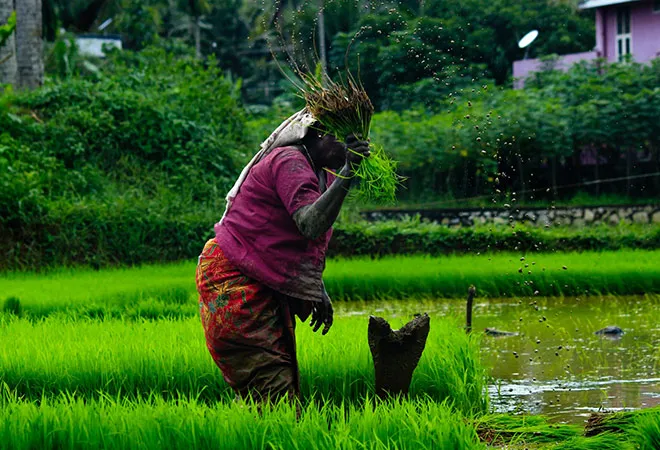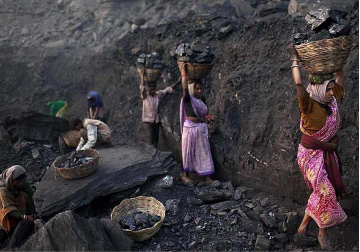 This article is part of the series — Raisina Files 2021.
This article is part of the series — Raisina Files 2021.
In 1810, German poet, artist and politician Johann Wolfgang von Goethe published
Theory of Colours, his treatise on the nature, function and psychology of colours.
An absorbing account, it is his description of the colour green that bridges the intuitive and visceral in a way that more than 200 years later still holds lessons for us. Green, he says, is the result of uniting the most fundamental and simple colours, yellow and blue. “Mixed in perfect equality so that neither predominates.” In the same vein, recovery from the economic shocks of the COVID-19 pandemic and avoiding severe future blows triggered by the climate crisis are not conflicting interests, but a mutually reinforcing coping strategy. Governments are pledging to rebuild again, to create jobs, spark growth and repair the damage done. But what will the rebuilt economy look like?
In a warming world, resilience and sustainability must serve as the cornerstone for long-term development. This mandates a new paradigm that de-links economic growth from greenhouse gas emissions.
A green recovery focuses on policies and solutions that will benefit people and the planet in the years ahead. Safeguarding the environment by protecting ecosystems and fighting the climate crisis is a key part of green recovery, as is investing in clean-energy jobs, securing public health, safety and civil rights, and prioritising climate justice. In this way, a green recovery seeks to build a new socio-economic model that is climate neutral, resilient, sustainable and inclusive.
Recovery from the economic shocks of the COVID-19 pandemic and avoiding severe future blows triggered by the climate crisis are not conflicting interests, but a mutually reinforcing coping strategy.
While the case for building a more sustainable development pathway is strong, the Indian economy is facing an existential crisis — teetering between a ‘business as usual’ approach and the transition to a green economy. India ranks negatively on the Greenness of Stimulus Index, due to a significant proportion of its stimulus going towards fossil fuels and environmentally intensive industries, but India has also been investing in green technologies, especially solar and battery storage.
By aligning economic recovery measures with the Sustainable Development Goals and Nationally Determined Contributions (NDCs), the poor and vulnerable — at the greatest risk from the deprioritisation of climate and ecological impacts — can be protected.
The post-COVID-19 period is an opportunity for India to promote sustainable agriculture and sustainable public procurement; resource efficiency and circularity across sectors and supply chains; and green jobs and green local enterprises. India could also link recovery efforts with the clean energy transition, nature-based solutions and its NDCs, such as through e-mobility or promoting off-grid renewable energy for applications like agricultural and vaccine cold-storages.
While crucial, these solutions are incomplete if not accompanied by the equally important imperative to be more inclusive in their approach. One way is to involve and safeguard more women in the post-COVID-19 world. The majority of crises hit the most vulnerable and marginalised populations — among which women are disproportionally represented — the hardest. The impact of the COVID-19 pandemic on women, especially those facing multiple forms of discrimination related to poverty, caste or disability, has been stark. Illustrated by a sharp decline in women’s participation in the labour force and education
, this inequality will only be exacerbated by climate change. At the same time, women serve as important levers of change that can stimulate the economy and develop climate resilience. Therefore, even though green jobs and the promotion of the green economy are pivotal for achieving economic and social development that is also environmentally sustainable, it cannot happen without gender equality, a vital component in the world of work to advance the greening of economies.
The majority of crises hit the most vulnerable and marginalised populations — among which women are disproportionally represented — the hardest.
Agriculture
The COVID-19 pandemic and subsequent lockdown revealed the staggering number of migrant workers, mostly male, that cross both state and rural-urban borders for employment.
Left in the wake of their city-lured aspirations are the women who take over the duties of the farm, leading to a widespread feminisation of Indian agriculture. The 2011 Census found that 65 percent of the total female workers in India were employed in agriculture, forming 30 percent of cultivators and 43 percent of agricultural labourers nationally.
In most cases, these women do not hold land titles in their name, excluding them from availing of a plethora of government schemes that mandate land ownership. Lacking access to robust education and financial literacy, these women are often not viewed as the primary decision-makers of the household.
Agriculture and climate change are inextricably linked — about 60 percent of farmland in South Asia is rainfed, leaving millions vulnerable to the effects of a shifting monsoon.
Crop failures can push rural communities into severe poverty, and are compounded by small landholding sizes and poor market linkages.
With many women engaged in agriculture but lacking access to adequate technology, training and credit, two distinct phenomena occur concurrently. First, a large percentage of farmers and farmworkers are being excluded from the sharing of best practices. Second, a warming world is exacerbating the burden that will be faced increasingly by female farmers and farmworkers, who in many cases lack agency and the means to adapt.
Left in the wake of their city-lured aspirations are the women who take over the duties of the farm, leading to a widespread feminisation of Indian agriculture.
Increasing women’s land titles and creating supportive legislation are promising steps, but are often mired in the complexity of implementation. Deeply entrenched gender norms, upheld by men and women alike, complicate seemingly straightforward interventions. In addition to being difficult to execute, increasing women's land ownership may not solve problems of women’s access to literacy or decision-making status in the household. Instead, interventions that aim to demonstrate women as an economic asset, who can generate income for their families through improved agricultural outputs, tend to be more holistic.
These interventions can enhance the position of women as leaders and decision-makers, building the long-term gender equity of the region.
Using women as a lever to develop climate-resilient sustainable agriculture can be best leveraged through existing socio-professional support networks. Self-help groups (SHGs) and state rural livelihood missions (RLMs) — women’s community organisations that offer aid and services related to agriculture, cottage industries and microcredit — exist across the country and are funded by state governments in many cases. The development sector has worked extensively in the training and capacity building of these organisations to help increase women’s digital and financial literacy and market access, opportunities to access microfinance and loans without land collateral, and knowledge sharing of best practices to increase the quality or yield of agricultural output.
These groups can also assist women in dealing with complex bureaucratic government machinery. For instance, research on gender disparities among cotton cultivators in Maharashtra found that 85 percent of women surveyed had never accessed government schemes, primarily due to a lack of knowledge.
Interventions that aim to demonstrate women as an economic asset, who can generate income for their families through improved agricultural outputs, tend to be more holistic.
In light of a green stimulus, SHGs and RLMs can be activated as vehicles for the widespread adoption of sustainable agricultural practices. Increased agroforestry, mixed cropping, improved irrigation methods, reduced fertiliser use, and integrated pest management can help diversify farmer livelihoods and simultaneously build healthy farm ecosystems that can withstand climate shocks. Swayam Shikshan Prayog (SSP), a women’s community organisation, worked extensively in the Marathwada region of Maharashtra to enable a “women-led climate resilient farming model” after severe drought caused a mass migration of men to cities.
In four years, SSP empowered women through training in key resilience practices, access to a low-interest fund, and community-level knowledge sharing. This led to a 25 percent increase in crop yield due to diversification practices, 25 percent savings per crop per cycle on input costs, improved local water sources and increased household savings.
Both social and economic measures are necessary in bringing about this change. Increasing the number of financial instruments available to women farmers that do not require land collateral and place emphasis on climate resilience are pivotal to bringing about ground-level change. In addition, interventions must be sensitive to women’s limited time capacity, given their existing responsibilities on the field and in managing the household, to ensure their ability to participate. Furthermore, sensitisation workshops for the community should also work with men to demonstrate women’s value as income providers, decision-makers and agents of change.
Increasing the number of financial instruments available to women farmers that do not require land collateral and place emphasis on climate resilience are pivotal to bringing about ground-level change.
Green jobs
India has one of the lowest female labour force participation rates globally — just shades above Syria, Iran, and the West Bank and Gaza, among a few others.
Some researchers estimate that 95 percent of India’s female workforce is engaged in the informal economy, due to high levels of unpaid housework and lagging female education.
The pandemic has exacerbated this crisis, with female labour force participation dropping to 11 percent (while males participation is 71 percent), and fewer women than men have recovered the jobs lost during the lockdown.
In this context, it is clear that women are an underutilised economic resource, and that growth and recovery will be limited in the absence of gender-focused interventions.
As new economies unfurl from nascent green transitions, several natural opportunities emerge to tap into this underutilised resource. These opportunities can be divided into two broad categories — increasing women’s participation in green industries and using green technology to enhance existing women-led micro-enterprises. The former s across geographies and skillsets but is centred around renewable energy management and proliferation. The latter is more specific to rural women, many of whom are already engaged in some cottage industry or agricultural work that can be strengthened by renewable energy access. Both categories make recommendations based on organic linkages between existing demographic trends and the industries of the future.
It is clear that women are an underutilised economic resource, and that growth and recovery will be limited in the absence of gender-focused interventions.
Solar energy, a favourite of the Indian government, has been growing rapidly, in line with India’s international climate and renewable energy targets. However, rooftop solar solutions, despite representing a major opportunity, has been slow on the uptake. According to a study conducted by the International Energy Agency and the Council on Energy, Environment and Water (CEEW), it is the most labour-intensive of prevailing renewable technologies — creating seven to 20 times more jobs than utility solar or onshore wind.
Furthermore, about two-thirds of jobs in the rooftop solar sector require high- or mid-level skills, especially in the realm of engineering. Over 30 percent of students studying engineering in India are female, one of the highest rates in the world, yet they are largely absent from many core business segments — and the upper echelons — of corporate rooftop solar.
This can be traced back to a plethora of reasons, including concerns about safety at project sites, misperceptions of women’s capabilities in certain (popularly imagined as masculine) roles, and insufficient HR policies or gender-sensitive workplace practices. Both government and corporate organisations can be used as tools to further gender inclusivity in the rooftop solar sector, unlocking a new segment of highly-educated and capable employees.
Unskilled workers also have a critical role to play in the adoption of green and sustainable technologies. Frontier Markets, a last-mile distribution company that aims to expand rural access through the digital marketplace, uses women as a lever to increase community uptake of clean energy products. These women, known as “solar
sahelis” (solar friends), work closely with villagers to overcome the scepticism towards these products, such as solar-powered flashlights, which often have higher upfront costs than their battery-powered counterparts.
These women are instrumental in expanding the reach of frontier markets and, in turn, are empowered by both their economic returns and their subsequent decision-making leverage in society. Similarly, in urban and peri-urban settings, Mahila Housing Trust (MHT) activates women community action-group-members to work with slum communities across various climate-resilience issues. These interventions range from conducting energy audits and increasing the adoption of energy-efficient devices
to painting rooftops white and building embankments to protect against the furies of summer and monsoon.
MHT’s model is built on the governing principle that improving women’s habitats affords them a “key financial asset that supports livelihoods, and makes the poor more resilient to heat stress, disease, and other hazards of climate change.”
Frontier Markets, a last-mile distribution company that aims to expand rural access through the digital marketplace, uses women as a lever to increase community uptake of clean energy products.
Many women in rural India both own and work at micro-enterprises and are often responsible for non-mechanised labour, which is extremely time-intensive. Furthermore, a study by CEEW found that erratic and poor-quality grid electric supply is a considerable bottleneck for several micro-enterprises across the country; this often leads to a loss of productivity and rampant use of kerosene or diesel.
Introducing machinery powered by distributed renewable energy (DRE) — from cold storage and food processors to sewing machines and looms — can provide a stable electric supply, thereby improving rural incomes, reducing time poverty and drudgery, and empowering local women. However, DRE equipment has a higher upfront cost than kerosene- and diesel-powered machinery.
Increased investments in this sector, through philanthropic funding, government subsidies or financial instruments, can increase women’s access to a stable and clean energy future.
Healthcare
India spends only 1.3 percent of its GDP on public health care,
among the lowest in the world. Within this limited spending, access to health services — especially among vulnerable populations — is not universal. A study conducted in four major northern Indian states revealed that gender discrimination in healthcare access was worse for female patients in the age groups of 0-18 years and above 60 years and female patients who lived at increasing distances from a hospital.
Another study posits that the average healthcare expenditure is lower among women than men, despite women suffering from a higher incidence of morbidity.
The challenge also is that such gender-based health studies are limited in number; gender discrimination in access to health has not been systematically studied in India and many other developing countries, primarily due to a lack of reliable data.
A key step in tackling the concurrent health and climate crises is to ensure that the millions of ASHA workers are full-time employees with higher salaries, which will help benefit India’s health system and revive the country’s severely impacted economy post the pandemic.
Increasingly destructive climate impacts magnify the situation of weak healthcare systems in India. Rising temperatures are predicted to increase the transmission of vector-borne diseases across temporal and geographic scales.
Moreover, climate change is projected to cause an increase in the occurrence and intensity of extreme weather events, such as droughts, cyclones and heavy rainfall in India.
Evidence suggests that there is a higher probability of disease outbreaks with the increase in extreme weather events.
Furthermore, women’s health is disproportionately affected by climate impacts, such as air pollution, heat events, and water-borne and nutrition-related diseases, due to gendered household norms and limited access to knowledge and services.
This means that India’s health sector will have to transform tremendously to deal with climate impacts, in addition to the existing burden of providing health services to all its people, particularly women.
India’s Accredited Social Health Assistant (ASHA) programme is likely the world’s largest army of all-female community health workers,
forming the backbone of the country’s health system. But ASHA workers are overburdened and underpaid — they are hired as volunteers and are paid on an incentive basis.
During the pandemic, ASHA workers were expected to deliver services beyond their usual mandate. A key step in tackling the concurrent health and climate crises is to ensure that the millions of ASHA workers are full-time employees with higher salaries, which will help benefit India’s health system and revive the country’s severely impacted economy post the pandemic.
Women’s health is disproportionately affected by climate impacts, such as air pollution, heat events, and water-borne and nutrition-related diseases, due to gendered household norms and limited access to knowledge and services.
Additionally, the Ministry of Health and Family Welfare’s National Action Plan on Climate Change and Human Health — aimed at creating awareness among the general population, healthcare providers and policymakers around the impacts of climate change on human health
— mentions that frontline personnel, namely auxiliary nurse-midwife, ASHA workers, and
anganwadi (rural child care) workers, must assist in the implementation of the plan at local levels. While adopting this action plan has been slow, it holds great potential to scale up climate change and health-related interventions driven by women workers at the grassroots level.
Conclusion
India has a tremendous opportunity to guide the global trajectory on climate change by adopting sustainable development practices. Local solutions are a starting point for implementation, but scaling them up is essential for such solutions to impact future climate scenarios significantly. Ensuring women’s full and equal participation, focusing on their substantial contribution to climate-compatible development programmes, is imperative to achieving a successful green recovery. While gender has been increasingly factored into international climate policy, progress in India has been slow to reduce gender-based disparities and involve women in climate change mitigation, adaptation and disaster risk-reduction policy decisions and management. Civil society and philanthropists must adopt a climate and gender lens by planning skilling and training programmes for women’s employment, focusing on green jobs, and improving women’s access to rights. Given that a significant portion of India’s workforce is employed in agriculture, there is a need to improve women’s entitlements as farmers and recognise their unpaid labour. There is also a need to create programmes that support community institutions to address structural governance challenges that constrain women’s participation in decision-making.
While treading towards a green recovery, India must accommodate a key demographic — adolescent girls. Research has shown that the vulnerability of adolescent girls to climate change due to the combined effects of age and gender discrimination has severe implications on many of their rights.
There is enormous potential for adolescent girls to play decisive roles in identifying practical solutions to address climate change. Government and civil society programmes must involve girls in designing, implementing, and measuring climate strategies. Training and education programmes must support girls to learn the skills needed to respond to climate impacts, take a prominent role in driving climate action, and hold leaders accountable to their commitments and responsibilities. A green recovery not only entails building back with reduced greenhouse gas emissions but also creating a sustainable, equitable, and inclusive society that enables a billion to thrive.
Johann Wolfgang von Goethe,
Theory of Colours (Cambridge University Press, 2014), pp. 316.
Nandini Sarma, “
Green Recovery: Opportunities for India,”
ORF Issue Brief no. 425, Observer Research Foundation, November 2020.
Vivid Economics and Finance for Biodiversity Initiative,
Greenness of Stimulus Index, Vivid Economics, February 2021.
Development Alternatives,
Building Back Better: Towards a Green Recovery of Indian Economy, Climate Policy Initiative, July 2020.
Billy Perrigo and Neha Thirani, “
How the pandemic is reshaping India,”
Time, 19 August 2020.
Cecila Ugaz Estrada and Müge Dolun, “
Industries post-COVID-19: A gender-responsive approach to global economic recovery,”
Green Growth Knowledge, 18 August 2020.
Madhunika Iyer, “
Migration in India and the impact of the lockdown on migrants,”
PRS Legislative Research, 10 June 2020.
Kritika Singh, “
Women’s ownership of land in rural areas can help cut poverty,”
Live Mint, 3 August 2016.
Suhas P Wani et al., “Rainfed Agriculture: Past Trends and Future Prospects,” in
Rainfed Agriculture: Unlocking the Potential, eds Suhas P Wani, Johan Rockström and Theib Oweis (London: CAB International, 2009), pp. 1.
SS Shinde and P Modak, “
Vulnerability of Indian Agriculture to Climate Change,”
Elsevier Reference Collection in Earth Systems and Environmental Sciences, vol. 2 (2013).
IDH the Sustainable Trade Initiative,
Business case for gender mainstreaming in cotton in Maharashtra, IDH and Sattva Consulting, 2019.
“Business case for gender mainstreaming in cotton in Maharashtra”
“Business case for gender mainstreaming in cotton in Maharashtra”
UN SDGs Partnership Platform, “
‘Women-led Climate Resilient Farming’ Model,” United Nations Sustainable Development Goals, 2015.
“‘Women-led Climate Resilient Farming’ Model”
“Business case for gender mainstreaming in cotton in Maharashtra”
World Bank, “
Labour participation rate, female (% of female population ages 15+) (modelled ILO estimate),” World Bank Group, 29 January 2021.
S Sundari, “
Structural Changes and Quality of Women’s Labour in India,”
Indian Journal of Labour Economics 63 (2020): 689-717.
Shruti Rajagopalan, “
Women Won’t Recover Easily from India’s Pandemic,”
Bloomberg Quint, 20 December 2020.
IEA and CEEW,
Women working in the rooftop solar sector, International Energy Agency, 2019.
“Women working in the rooftop solar sector”
Annie Banerji, “
Women in India are tackling the rural energy crisis with solar power,”
World Economic Forum, 22 November 2018.
SELCO Foundation, “
Sheetal Pal for Our Climate Solutions – Young Voices Tackling the Climate Challenge,”
YouTube, 15 June 2020.
SELCO Foundation, “
Mayurika for Our Climate Solutions – Young Voices Tackling the Climate Challenge,”
YouTube, 22 June 2020.
Mahila Housing Trust, “
Mission and Approach,” Mahila Housing SEWA Trust.
Sanchit Waray, Sasmita Patnaik and Abhishek Jain,
Clean Energy Innovation to Boost Rural Incomes, New Delhi, CEEW and Good Energies Foundation, 2018.
“Clean Energy Innovations to Boost Rural Incomes”
Devjyot Ghoshal and Aditya Kalra, "
Indian Doctors Fight Coronavirus With Raincoats, Helmets Amid Lack Of Equipment,"
Reuters, 31 March 2020.
Mudit Kapoor et al., "
Missing female patients: an observational analysis of sex ratio among outpatients in a referral tertiary care public hospital in India,"
BMJ open 9, no. 8 (2019): e026850.
Moradhvaj and Nandita Saikia, "
Gender Disparities In Health Care Expenditures And Financing Strategies (HCFS) For Inpatient Care In India,”
SSM - Population Health 9, (2019): 100372, doi:10.1016/j.ssmph.2019.100372.
Rob Jordan, “
Stanford researchers explore the effects of climate change on disease,”
Standford, 15 March 2019.
Mayank Aggarwal, "
Climate Change Increases India’s Vulnerability To Extreme Weather Events: Report,"
Mongabay India, 4 December 2018.
Anthony J McMichael, "
Extreme weather events and infectious disease outbreaks,"
Virulence, no. 6 (2015): 543-547.
Sorensen Cecilia et al., "
Climate change and women's health: Impacts and opportunities in India,"
GeoHealth 2, no. 10 (2018): 283-297.
R. Ved et al., "
How are gender inequalities facing India’s one million ASHAs being addressed? Policy origins and adaptations for the world’s largest all-female community health worker programme,"
Human Resources for Health 17, no. 1 (2019): 1-15.
Abhishyant Kidangoor, "
1 Million Women Healthcare Workers Have Been Drafted To Fight COVID-19 In India — For As Little As $40 A Month,"
Time, November 2020.
Ministry of Health & Family Welfare,
National Action Plan For Climate Change & Human Health, Government of India, 23 October 2018.
Plan International,
Climate Change: Focus On Girls And Young Women, Plan International, 2019.
The views expressed above belong to the author(s). ORF research and analyses now available on Telegram! Click here to access our curated content — blogs, longforms and interviews.



 This article is part of the series —
This article is part of the series —  PREV
PREV





